#Aurelia JavaScript framework
Explore tagged Tumblr posts
Text
Aurelia JS Overview
Aurelia JS Overview Aurelia is a modern, front-end JavaScript framework for building browser, mobile, and desktop applications. Learn More Here : https://phptutorialpoints.in/aurelia-js-overview/ #php #phptutorial #phptutorialpoints #webdevelopment #webdevelopmenttutorial #aureliajs #aureliajstutorial #aureliajsdevelopment #aureliacli #aureliaframework #aureliajavascriptframework
In this article, we’ll see Aurelia JS Overview. What is Aurelia? Aurelia is a modern, front-end JavaScript framework for building browser, mobile, and desktop applications. It focuses on aligning closely with web platform specifications, using convention over configuration, and having minimal framework intrusion. Aurelia JS is designed to work seamlessly with modern web standards and…

View On WordPress
0 notes
Text
The Top 10 Most Popular Frontend Frameworks for 2023
Frontend development has become an essential part of the technological world. It allows developers to build and create user interfaces quickly and easily. With the plethora of options available, it can be overwhelming to decide on the right frontend framework to use. In this article, we will explore the top 10 most popular frontend frameworks for 2023, analyzing their key features and…

View On WordPress
#Angular#Aurelia#Backbone.js#Ember.js#Frontend Development#JavaScript#Meteor#Mithril#open-source#React#Stimulus#Svelte#user interfaces.#Vue.js#web design#web development#web frameworks
0 notes
Video
tumblr
Top Javascript frameworks in 2021 Angular ReactJs Vue.JS Ember.JS Aurelia
Want to know 5 more ?
Check our blog>> Top Javascript Frameworks in 2021
1 note
·
View note
Note
i need your opinion! i'm torn between the names Aurelia and Aurora, i really like both but i'm not sure which one is the better option for my character. it'd be great to hear another take on what could suit :)
Agh, I understand this plight all too well. Aurelia has long been one of my favourite names, and Aurora is breathtaking too. Aurelia means gold and Aurora means dawn, so even the meanings are equally gorgeous.
I will say, however, that Aurora has associations that Aurelia does not. Aurora is both a Disney princess and a naturally occurring electrical phenomenon in the sky - both of which are beautiful, but they will likely come to a person’s head before your character does.
Aurelia is the Portuguese-speaking character in Love, Actually, but other than that (unless you’re familiar with the JavaScript framework of the same name), it’s association-free, so the name will belong especially to your character.
This is all subjective of course; we all think of a different Harry when the name comes up. So the choice is yours. I actually find that flipping a coin helps - if only to show you whether you’re relieved/disappointed when forced to choose one. If it lands on tails and you’re disappointed, go with heads.

#rph#character help#name help#names#flip a coin#it seems like stupid advice but try it and then go with your gut#Anonymous#aq#advice
14 notes
·
View notes
Link
Aurelia is only framework that allows developers to building browser, mobile, and desktop applications. Aurelia has variety of functionalities that helping in program feature rich web applications. Cheu have highly skilled aurelia developers team known for building responsive web applications which is compatible for all browsers on mobile and desktop platforms. For more details, visit: https://www.chetu.com/on-demand-developers/javascript/aurelia.php now!

#aurelia development#aurelia development services#aurelia development solutions#aurelia solutions#aurelia developers#hire aurelia developers
1 note
·
View note
Text

AURELIA JS STAFFING AGENCY
Aurelia is a modern JavaScript Framework that enables you to write simple code to create complex applications. It provides everything you need to get started quickly, including a robust templating engine, dependency injection, and a module loading system.
visit- https://apptiansitstaffing.com/resources-technologies/javascript-technology/aureliajs/
Aurelia #javascript #javascriptdeveloper #staffing #staffingagency #recruitment #recruitmentagency
0 notes
Text
Benefits of Angular app development and its top 5 alternatives?
Billions worldwide use Web and mobile apps for practically everything, from social networking to healthcare and retail to online banking. These applications are helpful and assist us in our daily lives by providing flawless user interfaces and experiences. These applications are designed to be so trustworthy & that part of the credit goes to popular frameworks like Angular, which make it simple to build vital programs.
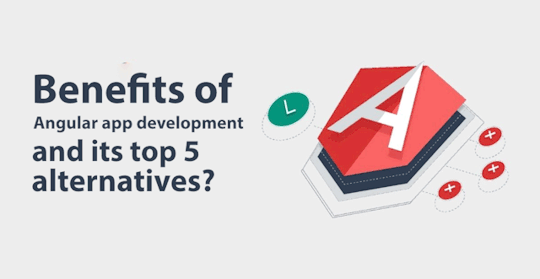
Angular is a term that refers to a style of design that is based on the TypeScript open-source JavaScript framework. Google runs it, and its primary goal is to create single-page apps. Angular offers many advantages as a framework, and it also gives developers a uniform structure to work with. It allows users to build massive, maintainable applications. One can also hire a team of angular app developers to work accordingly.
The following is a list of some benefits of Angular web development:
Features that are supported by SPAs are:
The primary motivation for creating single-page apps is to make website transitions go more quickly. The website will work and seem like a native application. Instead of the browser's typical way of loading whole new pages, a website will interact with it by dynamically changing the old web page with new Web server data. A one-page application is what this is known as (SPA).
Single Page Applications (SPAs) can be developed with AngularJS. When a programmer uses AngularJS to create a single page application, the page loads quickly, is cross-platform compatible, offers a great user experience, and is much easier to maintain.
It features a Two-Way Binding Feature:
AngularJS provides for instantaneous synchronization of the view and the model. The statement reflects any changes made to the model's data. The model is updated in response to changes in the view data.
The application's display layer will be significantly simplified because of this two-way data coupling. This provides a more straightforward and unobtrusive approach to DOM display while building the user interface.
It has a graphical user interface (GUI) that is declarative
The AngularJS framework uses HTML to construct templates. Hence it has a declarative user interface. Because of its scalability and inherent intuitiveness, it is a popular declarative language. Filters, directives such as ng-app, ng-repeat, ng-model, form controls, and other AngularJS-specific components and properties are included in templates.
A declarative user interface aids in the comprehension and manipulation of information. HTML facilitates collaboration between developers and designers. Designers may concentrate on building UI while developers utilize declarative binding vocabulary to link UI components to data models.
Although the framework may not be necessary to many developers, the material ultimately determines the strength of the structure. Each framework or library has its benefits and drawbacks, and developers must choose which framework to employ. While Angular has had a lot of success since its first release, many other options are steadily gaining traction.
Alternatives to Angular (top 5)
Below are the top 5 alternatives for angular:
Aurelia is a cutting-edge open-source UI framework for building online and mobile apps. It enables the creation of complicated apps using only JavaScript or TypeScript. It adheres to the most recent JavaScript guidelines. Aurelia is easy to use and offers a good API. Aurelia is both concise and straightforward, as well as robust and adaptable. Aurelia is a modular framework consisting of various libraries that may be used alone but make a solid and reliable framework when combined.
Aurelia takes a proactive and current attitude. Forward-thinking, two-way data binding, custom HTML elements, testing, and more benefits and features are available. Aurelia is a developer-friendly platform that is simple to use. Aurelia is the most excellent angular alternative for individuals who want to work on cutting-edge JavaScript apps.
Backbone is a single-page application development library written in JavaScript. It's built on the Model-View-Presenter (MVP) design pattern, which abstracts data into models, the DOM into views, and ties the two together via events. Backbone.js has been around for a long time and has a well-developed platform.
Backbone includes a RESTful JSON interface, back-end synchronization, and event-driven communication capabilities. The backbone enables the development of well-structured and ordered online and mobile apps.
Ember is a JavaScript framework that is free to use. By utilizing best practices in a framework, developers may create scalable single-page apps. The Model-View-View-Model (MVVM) paradigm is used in Ember.
Ember is utilized by several well-known websites, including LinkedIn, Vine, Nordstrom, etc. Mobile and desktop applications can also be made with Ember. Apple Music is one example.
Ember includes debugging tools such as Ember CLI, Ember templates, and the Ember Inspector tool. Ember provides a user-friendly API that is simple to comprehend and use.
The Meteor framework is a complete web and mobile development platform that uses pure JavaScript. It's a client-side and server-side JavaScript framework that's free and open source. Meteor connects natively with MongoDB, allowing data updates to be propagated to the client without additional code. Meteor features its design template engine and can be used with the Angular, React, and Vue frameworks.
Meteor is the most excellent Angular alternative since it is a full-stack framework that can be used to develop any type of application. Meteor is famous among developers since it is simple to understand and allows for speedier development.
The most famous alternative to angular in the current era is this. Single Page Applications can be built using Mithril, a modern JavaScript framework. XHR, routing and routing utilities are all provided in this small project (*8kb grip). Mithril is used by companies like Nike and Vimeo and open-source platforms like Liches.
It already has available documentation for everyday tasks. Mithril is all about getting meaningful work done efficiently. Mithril is a complete platform for building web and mobile apps in pure JavaScript.
Conclusion
Since technical innovation occurs regularly, no technology can remain popular indefinitely. Users' needs change over time. Thus firms must seek out solutions to ensure consumer pleasure. Although Angular has been a popular choice for many specialists and a great UI development platform, it is critical to grasp its alternatives for your organization's future. This article discussed the most excellent Angular options and their beneficial characteristics in-depth.
0 notes
Text
How to Choose Hybrid App Development Framework for Your Business?
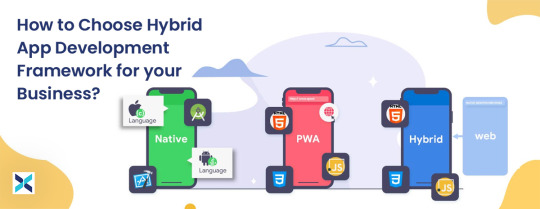
One of the reigning mobile app development trends is taking the hybrid development approach. The quicker release, smoother app development process, and reusable code can be attributed to taking this route. With a plethora of options available for developing hybrid apps, it has become essential for mobile app developers to choose the proper framework for their business. However, before we touch upon the steps you have to take to select a good framework, let’s take note of all the frameworks available at the moment that help with hybrid development.
Hybrid App Development Frameworks
#1 Ionic
Ionic framework gained popularity immediately after its release in the market. Its native-like experience and smooth performance made developers choose the platform and develop apps. In addition, the documentation, a ready-to-help community, and ever-evolving features allow you to create extensive functionality and instantly bring your apps to the market. The only flip side to this otherwise exciting framework is the intense learning curve associated with it. It is not your regular DIY framework that you can use to build a solid solution. Instead, you are dependent on developers to help you around with mobile app development.
#2 Flutter
Flutter comes with lots of features that make it essentially the best framework for building your mobile apps. As a result, many mobile app development companies have started offering flutter solutions to create platform-agnostic applications. Few features include hot reload and VI editors that appeal to the developer and create useful apps faster. In addition, implementing friendly designs is easier with Flutter, as it provides a drag-and-drop design interface.
#3 React Native
If you are planning development in 2021, you must partner with a promising React Native development company. This is one of the lightweight and accessible frameworks that allow you to create able platform-agnostic applications. This framework gives you a native-like experience. With React Native, you can build apps similar to the ones you would create using Objective-C or Android technologies. The only thing to take care of when building apps with React Native is adding the necessary security layers. Make sure to add the essential security for the business apps.
#4 Xamarin
This is a Microsoft product and is highly recommended for mobile app development as well as testing. It offers a broad scope for the developers. The mobile apps bear a native-like experience and provide extensive features. However, the learning curve is steep, and it is recommended to partner with a developer to build your mobile apps.
#5 Kendo UI
This hybrid framework comes with several JavaScript UI components and built-in JQuery, Angular, and React libraries. Along with the libraries, you also get several widgets that make your life as a developer smooth. As a result, you can accelerate the development of high-performance and incredible app solutions with this framework. The world-class support, open-source nature for enterprise, and strict QA process make it the best framework for developing hybrid app solutions.
#6 Framework7
This framework belongs to the list of few that command the HTML technology to devise hybrid solutions. You can combine this technology with Electron and NW.js to create native-like desktop apps. This framework is majorly used for prototyping and uses Google’s material design to create the solutions. In addition, it contains the components of other frameworks that make it exciting and design-friendly. You are now aware of some of the frameworks that are used in developing hybrid app solutions. There are others, too, such as PhoneGap, Onsen UI, JQuery Mobile, and Aurelia. These popular frameworks offer the developers a free hand to deliver the custom app solution that fits the business requirements. With so many frameworks doing the round and aiding developers offer the apt solution, choosing the ideal solution for your business becomes essential. Here, we will take you through all the things you should consider when selecting the development framework for your hybrid app solution.

Factors to Consider When Choosing the Framework
With almost all the frameworks offering similar flexibility or capability, it becomes challenging to make a choice. Here are a few pointers that might help.
1. List the Native-like Features
Continue Reading: hybrid mobile app development company
#hybrid app development#mobile app development company#hybridapp#android#appdevelopment#ios#mobileapp#mobileappdevelopment#androidapp#iosapp#hybridappdevelopment#planning#framework#business#expertappdevs#ead
0 notes
Text
Aurelia Vs Angular: The Comparison & Verdict Which One is Better
Aurelia and Angular are two popular JavaScript front end development framework. While Aurelia is a comparatively new JavaScript framework, AngulerJS is an old yet widely accepted web application framework and is backed by Google. Now, that’s not the only difference you in between Angular and Aurelia. There is to more find in the ongoing debate of Aurelia Vs Angular to make the right choice at the end.
Read More at – Aurelia Vs Angular: The Comparison & Verdict Which One is Better
#aurelia vs angular#angularjs development services#angularjs development company#front end development services#front end development company
0 notes
Link
キーポイント WebAssembly has perhaps been the most talked about trend on the web since our last report. Applications for WebAssembly have moved beyond the browser via WASI, and WebAssembly reached a stable 1.0 W3C Recommendation in late 2019. We have thus promoted WebAssembly to Early Adopters status. The annual ECMAScript release, ES2020, is approaching with the greatest number of new language features since ES2015, including optional chaining, BigInt, globalThis, nullish coalescing, and dynamic import. All of these features are considered stable with at least two working browser implementations. Web components have moved from early adopter to early majority status. Web components have reached mainstream maturity and are now supported natively in Chrome, Firefox, Safari, and other browsers based on these browser engines such as Edge and Brave TypeScript has graduated to late majority status. TypeScript is by far the most widely adopted JavaScript variant, has made substantial progress over the past few years, and a majority of JavaScript frameworks now leverage its tooling and infrastructure. The JavaScript client-side framework and library space is constantly changing, and while React, Vue.js, and Angular have dominated in recent years, a new wave of leaner frameworks and application compilers may change the status quo over the next few years. 原文(投稿日:2020/03/12)へのリンク InfoQでは、定期的にトピックグラフを更新して、さまざまなトピックがテクノロジー採用曲線のどこにあると考えるかを示しています。その際、ネットワーク内や会合、会議、アナリストイベントなどで聞いた実践状況、新たなアイデアや事柄を考察します。また、サイトのトラフィックパターンやQConや他の業界カンファレンスなどのセッションへの出席者数も考慮します。 トピックがグラフの右側にある場合は、おそらくInfoQの既存のコンテンツを多く見つけるでしょう。 – InfoQは新しいうちにそれをカバーしています。また、イノベーターとアーリーアダプタが学んだ教訓は、個人、チーム、組織がこれらのアイデアや実践を採用するときに、ガイドとして利用できます。 曲線の左側のトピックは、イノベーターやアーリーアダプタが使用している現在存在感を増しているトピックであり、InfoQのレポートやコンテンツは、これらのアイデアを読者に届けることに重点を置いており、読者は、今、これらのアイデアを探求すべきか、それともその展開を待つべきかをご自身で判断していただけるようになっています。 レポートは、InfoQ編集チームが現在JavaScript/Web開発スペース内でのテクノロジーの採用と存在感を増しているトレンドをどのように見ているかの概要を提供します。これは、アクティブなソフトウェアエンジニア自身である編集者との広範な内部ディスカッション、外部のパブリックサーベイ結果のレビュー、内部またはプライベートのサーベイおよび分析結果のレビュー、およびWebコンポーネントなどの主要なテクノロジーのブラウザのサポートレベルの確認から形成された意見です。 今月はJavaScriptとWeb開発に注目します。急速に変化するこの業界では、年に1回以上の更新が必要です。これは、2018年の第4四半期にグラフを最後に確認したときのグラフです。 Web Development 2018 Q4 GraphJavaScriptとWebエコシステムがどれほど成長したかを考えると、1つのグラフにすべての領域を表示することはもはや現実的ではありません。その結果、分析を11の主要分野に分割しました。 Web開発 言語 / 標準 / パターン Web開発 クライアントサイドフレームワーク / ライブラリ Webエンジニアのためのサーバサイドプラットフォーム / フレームワーク / データ / API Webエンジニアのためのクラウド パッケージ管理 / バンドル / 最適化 Web開発のテストと自動化 Webエンジニアのためのモバイル / デスクトップ環境とフレームワーク WebエンジニアのためのIoT / ブロックチェーン / 機械学習 WebエンジニアのためのVisualization / XR CSS Web開発 コードエディタとIDE Web開発は私たちにとって常に興味深いものであり、新しいJavaScriptプロジェクトがほぼ毎日開始されています。どれに焦点を当て、どれを無視するかを決定することは、特に困難です。開発者は、日々の開発作業で現在使用していない場合でも、興味深いアプローチから学び、インスピレーションを得ることができます。 Web開発 言語 / 標準 / パターン Language/Standards/Patterns 2020 Q1イノベーター(Innovators) ECMAScriptの年次リリースであるES2020は、オプションのチェーン、BigInt、globalThis、nullish coalescing、動的インポートなど、ES2015以降で最も多くの新しい言語機能に近づいています。これらの機能はすべて、少なくとも2つの有効なブラウザ実装で安定していると見なされます。 PureScriptはTypeScriptの代替言語を提供します。最近のJavaScript 2019の調査では高得点を記録しましたが、近い将来にイノベーターのステータスを超えて進むかどうかについては議論があります。 アーリーアダプタ(Early Adopters) アーリーアダプタを見て��JavaScriptの静的型チェッカーであるFlowと、JavaScriptベースのWebアプリを生成するためのJavaScriptの代替言語であるElmとReasonを引き続き追跡します。TypeScriptの台頭により、Flowの関心と開発は衰えたように見えますが、変化に備えて追跡しています。 前回のレポート以来、WebAssemblyはおそらくWebで最も話題になったトレンドでした。WebAssemblyのアプリケーションはWASIを介してブラウザを超え、WebAssemblyは2019年後半に安定した1.0 W3C勧告に達しました。これにより、WebAssemblyをアーリーアダプタのステータスに昇格させました。 従来のW3Cプロセスに加えて、Web Incubator CG (WICG)は、幅広い新機能と可能な標準を提案し続けています。また、Web Audioは、Webプラットフォームをさまざまなオーディオアプリケーションで実行可能にするために、引き続き注目を集めています。 アーリーマジョリティ(Early Majority) 関数型およびリアクティブプログラミングパターンは、JavaScriptアプリケーションを最も効率的に構築する方法に関する議論を支配し続けています。Vue.jsの創設者であるEvan You氏は、プロジェクトがTypeScriptに切り替えられたとしても、「皮肉にもTypeScriptはクラスを使用するよりもクラスを回避するのに役立つと思います。Vue3は、クラスの使用が0の100%TSコードベースです。」 Webコンポーネントはアーリーアダプタからアーリーマジョリティステータスに移行しました。Webコンポーネントは成熟した主流になり、ネイティブにサポートされるChrome、Firefox、Safari、およびEdgeやBraveのようなこれらのブラウザエンジンに基づくブラウザでサポートされました。多数のフレームワークとライブラリも、Angular、Dojo、Ionic、Stencil、Svelte、Vue.jsなどがWebコンポーネントをネイティブにサポートしています。 ES2019とAMPの2つのアイテムをアーリーマジョリティカテゴリに直接追加しました。 ES2019は、#smooshgate論争、Object.fromEntries、および文字列とオプションのキャッチバインディングに対するいくつかの小さな改善の後に、flatとflatMapメソッドを配列に追加しました。この比較的小さな新しい機能セットは、JavaScript開発者のアーリーマジョリティによって現在使用されています。 AMPは、Webの高速化を目指す代替手段であり、OpenJS Foundationに参加しました。InfoQはこれまでこれを採用することに抵抗し、既存のオープンWeb標準を使用することを好みましたが、AMPは引き続きメディアやニュースWebサイト全体で採用を続けています。 レイトマジョリティ(Late Majority) JavaScriptエコシステムが成熟するにつれ、置き換えられたサインを示さないレイトマジョリティカテゴリーの基盤テクノロジーがあり、ほとんどすべてのJavaScript開発者によって使用されています。 HTML5とES6/2015 - ES2018はレイトマジョリティです。今日、ほぼすべてのWebアプリケーションがこれらの機能を最小ベースラインとして使用しているためです。 TypeScriptもレイトマジョリティステータスに卒業しています。TypeScriptは、これまでで最も広く採用されているJavaScriptバリアントであり、過去数年間で大幅な進歩を遂げており、JavaScriptフレームワークの大部分は現在、そのツールとインフラストラクチャを利用しています。TypeScript自体は、最近のGitHub Octoverseレポートによると、上位10言語の1つであり、JSの現状調査では、TypeScriptが最も広く使用されているJavaScriptバリアントとしてリストされており、調査対象の50%以上がTypeScriptを使用しており、 JavaScriptのスーパーセットについて好意的な意見があります。 ラガード(Laggards) 私たちは、多くのアプリケーションでまだ使用されているが、新しい開発の取り組みには大きな関心を寄せていない、ラガードでレポートを締めくくります。ES5とHTML4に取って代わったのは新しいバージョンですが、ES5とHTML4の基礎となる機能は、JavaScriptとHTMLの最新バージョンに見られる多数の機能で構成されています。 Web開発 クライアントサイドフレームワーク / ライブラリ JavaScriptのクライアントサイドフレームワークとライブラリは常に変化しており、近年はReact、Vue、Angularが主流を占めていますが、よりスリムなフレームワークとアプリケーションコンパイラの新たな波が今後数年間で現状を変える可能性があります。 Client-side frameworks/libraries 2020 Q1イノベーター(Innovators) Vue.js 3はこのレポートの時点では出荷されていませんが、TypeScriptを使用してリライトされるVueは非常に期待されます。 アーリーアダプタ(Early Adopters) Dojoは引き続き、無駄のないTypeScriptファーストのフレームワークを提供するための道を歩んでいます。Dojoは、リアクティブWebアプリケーションを構築する上で非常に現代的な効率的な手法を提供し、TypeScriptと開発者の人間工学を強く取り入れています。DojoはOpenJS Foundationの一部です。 Emberは先頃、新しいコンポーネントモデルとリアクティブシステムを提供するEmber Octaneを発表しました。 LitElementはPolymerの後継で、軽量のWebコンポーネントを作成するためのJavaScriptライブラリを提供します。 Aureliaは引き続き忠実なファンを獲得しており、コンポーネントベースのアプリケーションを構築するための環境を作成するための作業を続けています。 Markoは、元々eBayで開始された別のOpenJS Foundationプロジェクトで、リアクティブUIコンポーネントの作成に重点を置いています。 TencentによるOmiは、Webコンポーネント、JSX、および統合ライブラリへのその他のコンポーネントアプローチをサポートするクロスフレームワークコンポーネント作成ライブラリです。 アーリーマジョリティ(Early Majority) アーリーマジョリティカテゴリで3つのプロジェクトがデビューします。 IonicのStencilは、最も人気のあるWebコンポーネント作成フレームワークになり、多くのフレームワークで使用するコンポーネントを作成するためのフレームワークであるOmiに似ています。 Svelteは、HTMLとの連携と、Disappearingフレームワークへのアプローチにより、Reactに代わる人気の高いものになっています。 Preactは、ReactライブラリへのAPIパリティ付きのReactの4 KB未満のgzip圧縮された代替手段です。 レイトマジョリティ(Late Majority) Angularはこのレポートの時点でリリース候補のステータスにあり、レイトマジョリティステータスに移行し、ついに待望のIvyレンダリングエンジンのアップデートが出荷されました。 Vue.js 2はまた、レイトマジョリティステータスに移行し、現在最も広く使用されているJavaScriptフレームワークの1つです。 Reactは依然として最も人気のあるJavaScriptレンダリングライブラリであり、前回のHooksのレポート以降、更新されています。 RxJSは引き続き人気のあるリアクティブ拡張ライブラリであり、Angularエコシステムで広く使用されています。 OpenJS Foundationの一部であるMomentは、日付と時刻の問題を管理するため��最も広く使用されているライブラリです。 Lodash(OpenJS Foundation)などのライブラリーの必要性は減り始めていますが、JavaScriptを操作するために広く使用されているライブラリーです。Core-jsは、最新のJavaScriptを操作するために広く使用されているライブラリでもあります。 ラガード(Laggards) Dojo 1.xとAngular 1.xはまだ広くデプロイされていますがメンテナンスモードです。jQueryは、いくつかの改善点はありますが、ほとんどが新しいHTMLおよびJavaScript機能、またはより本格的なフレームワークに置き換えられています。 Webエンジニアのためのサーバサイドプラットフォーム / フレームワーク / データ / API JavaScriptのサーバサイドエコシステムは、最近多くの関心を集めています。重要な革新の1つは、サーバサイドレンダリング、静的な事前レンダリング、ビルド時のレンダリングに移行し、現在のアプリケーションで使用されているリアクティブプログラミングモデルを変更することなく、クライアントサイドのJavaScriptワークロードを削減することです。 サーバサイドとAPIとクライアントサイドの違いは曖昧であるため、このカテゴリには、静的な生成、データ、状態管理、およびクライアントサイドとサーバサイドの間で共有されることが多いAPIアプローチも含まれます。 Server-side platforms/frameworks/data/APIs 2020 Q1イノベーター(Innovators) Denoは1.0リリース近くです。元のNode.js作成者であるRyan Dahl氏によって作成されたDenoは、Node.jsに代わるTypeScriptの作成に努めています。 Dojoは、ビルド時レンダリングアプローチを追加しました。これにより、アプリケーションのビルド時にNode.js機能を利用できるようになり、静的なサイト生成のためのさまざまな機能が可能になります。他のソリューションと比較して、Dojoのアプローチはコンポーネントレベルで機能し、主要なパターンと機能のブロックを備えた非常に再利用可能なアプローチを提供します。さらに、Dojoストアは、一般的な状態管理パターンのサポートが組み込まれた、予測可能で一貫性のある状態コンテナを提供します。 Hasuraは、GraphQLサーバを作成するためのいくつかのオープンソースオプションの1つです。State of JS 2019 Rising Starsレポートによると、2019年にはHasuraへの関心が大幅に高まりました。 アーリーアダプタ(Early Adopters) 最初にExpressを作成したチームによって開発されたNode.jsフレームワークであるKoaへの関心は、引き続き関心を集めています。 Nuxtは、サーバ側レンダリング、静的サイト生成、または単一ページアプリを提供するVue.jsフレームワークです。 StrapiとStoryblokは、オープンソースのヘッドレスコンテンツ管理システムです。組織が今日のリアクティブ、コンポーネントベースのアーキテクチャで最新のコンテンツ管理オプションを提供しようと努めているため、この分野は大きな関心を集めています。 ApolloはGraphQLの人気のあるオプションであり、もともとMeteorフレームワークから登場しました。 アーリーマジョリティ(Early Majority) Nest.jsはTypeScriptで作成されたNode.jsフレームワークで、フルスタックのTypeScript開発を可能にするためのさまざまなオプションと機能により、人気が急速に高まっています。 Next.jsは、Reactアプリケーションのサーバサイドフレームワークであり、サーバサイドレンダリング、静的サイト生成などをサポートしています。 GatsbyはGraphQLを活用してさまざまなソースからデータを取得し、Reactベースのアプリケーションに効率的なレンダリングオプションを提供します。 FastifyはOpenJS Foundationプロジェクトであり、高性能のNode.js WebフレームワークとしてExpressに代わる新しい選択肢です。 MobXは、採用され続けているReduxの代替の状態管理です。 レイトマジョリティ(Late Majority) Node.jsはサーバサイドでJavaScriptを実行するためにこれまでで最も広く使用されているアプローチであり、Electronのような環境でWebテクノロジーを使用してデスクトップアプリケーションを作成するための基盤でもあります。Node.jsはOpenJS Foundationの一部です。 Expressは現在でも最も広く使用されているNode.js Webフレームワークであり、OpenJS Foundationプロジェクトでもあります。 RESTは依然としてAPIを作成するために最も広く使用されているアプローチですが、GraphQLは、すべてのAPIエン���ポイントを事前に定義する代わりに、クエリベースの代替手段として大きく採用されています。組織がAPIへのアプローチでRESTとGraphQLを一緒に活用することも一般的です。 Reduxは、JavaScriptアプリケーションの状態管理に最も広く使用されているアプローチですが、小規模または単純なアプリケーションではあまり使用されていません。 Webエンジニアのためのクラウド Webエンジニアがクラウドベースのアプリケーションを作成および展開するのに役立つ幅広いソリューションが登場しました。 Cloudイノベーター(Innovators) Architectは、サーバレス JavaScript、Python、Rubyアプリケーションの作成をサポートするOpenJS Foundationプロジェクトです。 アーリーアダプタ(Early Adopters) AWS Amplifyは、AWSでモバイルおよびウェブアプリケーションを構築するための開発プラットフォームを提供します。 Netlifyは、Webアプリケーションを迅速に展開するための一般的な選択肢の1つです。 Azure SDK for JavaScriptは、その柔軟なIoTおよびCognitive Services APIにより、主に人気が高まっています。 アーリーマジョリティ(Early Majority) AWS Lambdaは、サーバレスJavaScript関数を実行することで人気が高まり続けています。 Zeit Nowは、静的およびJAMstackデプロイメント、サーバレス機能、およびグローバルCDNとして、Webアプリケーションをデプロイする一般的な方法です。 Google Cloud Functionsは、サーバレスJavaScript関数を実行するためのGoogleクラウドアプローチを提供します。 Googleのもう1つのサービスであるFirebaseは、クラウドベースのモバイルおよびWebインフラストラクチャを提供します。 パッケージ管理 / バンドル / 最適化 バンドル、パッケージ管理、および全体的なアプリケーションの最適化は、JavaScriptおよびWebアプリケーション開発における重要なトピックであり続けます。 Package management/bundling/optimizing 2020 Q1イノベーター(Innovators) pikaは、ESモジュールでサポートされている環境で構築およびデプロイされるJavaScript用のツールを提供することに焦点を当てています。 Entropicは、単一のフェデレーションレジストリではなく、より分散されたパッケージ登録アプローチを備えたnpmの初期段階の代替手段です。 アーリーアダプタ(Early Adopters) Parcelは、ますます人気のあるWebアプリケーションバンドルです。このレポートの時点で、Parcel 2はリリースの準備がほぼ整っています。 webhintは、アクセシビリティ、速度、およびブラウザー間の互換性を改善するためのリンティングツールを補完するOpenJS Foundationプロジェクトです。 アーリーマジョリティ(Early Majority) Prettierは、JavaScript開発でのコードのフォーマットに関するほとんどの議論を終わらせた独断的なコードフォーマッタです。 ESLintは、JavaScriptアプリケーションのエラーとアンチパターンを見つけるための豊富なアプローチを提供する別のOpenJS Foundationプロジェクトです。スタンドアロン製品としてのTSLintは非推奨となり、ESLintの拡張機能になりました。 Esprimaは、抽象構文ツリーの操作を支援するために広く使用されているECMAScriptパーサであり、OpenJS Foundationの一部でもあります。 Yarnは、npmパッケージレジストリを利用するnpmの代替パッケージマネージャです。 Rollupは、Svelteと同じチームメンバによって作成されたESモジュールバンドルです。Rollupはライブラリとモジュールに広く使用されているのに対し、webpackはアプリケーションに一般的に使用されています。 レイトマジョリティ(Late Majority) NPMは、JavaScriptの事実上のパッケージマネージャーおよびレジストリです。npmは2019年にさまざまな論争に直面し、エコシステムは近い将来代替案を探す可能性があります。 webpackは、JavaScriptエコシステムで最も広く使用されているモジュールバンドルおよびコードオプティマイザです。 BabelはJavaScriptトランスパイラを提供し、開発者は開発で新しい言語機能を使用できますが、本番環境では古いバリアントにデプロイできます。Babelは最近、TypeScriptトランスパイレーションも追加しましたが、型チェックを提供しないため���用途が限られています。 Lighthouseは、Googleがアプリケーションコードの品質とパフォーマンス���向上させるために作成した、広く使用されている自動化ツールです。 Web開発のテストと自動化 JavaScriptでテストを作成および実行するための多くのオプションがあります。簡潔にするために、Chai、Sinon、Jasmine、QUnit、Cucumber、および非常に便利で人気のあるテスト機能を提供する他の同様のライブラリの分析を除外しましたが、これらのライブラリおよび他の多くのテストソリューションの進歩を引き続き追跡しています。 Testing and automation 2020 Q1イノベーター(Innovators) Playwrightは、ブラウザの自動化とテストのためのPuppeteerに新しくリリースされた代替手段です。Puppeteerとは異なり、Playwrightはすべての最新のブラウザーレンダリング環境を対象としています。 機械学習ベースのテストは、テストの生成を自動化する新しい分野です。Applitools、SauceLabs、Testim、Sealights、Test.AI、Mabl、ReTest、ReportPortalなど、この問題を解決しようとする企業があり不足しているわけではありません。この分野には明確な正解はありませんが、近い将来に変わると予想されます。Visual AIテストは、従来のビジュアル回帰テストの代替としても登場しています。 アーリーアダプタ(Early Adopters) Appiumは、Seleniumから登場したW3C WebDriverプロトコルを使用した、ネイティブ、ハイブリッド、モバイルのWebアプリ用のテスト自動化フレームワークです。AppiumはOpenJS Foundationプロジェクトです。 Internは、ユニット、機能 (WebDriverを介して、またはPuppeteerやPlayrightのような他の環境で) 、統合、パフォーマンス、およびその他の種類のテスト用にTypeScriptで作成されたOpenJS Foundationプロジェクトです。 Avaは、Node.jsアプリケーションの人気のあるテストランナーです。 WebdriverIOはOpenJS Foundationプロジェクトであり、WebDriverプロトコルに基づく機能および統合テスト環境を提供します。 アーリーマジョリティ(Early Majority) Cypressは、最近FirefoxとEdgeのサポートを追加したChromiumベースのブラウザ内のエンドツーエンドのテストランナーとして急速に人気を博しています。 Storybookは、UIコンポーネントを作成、テスト、共有するためのテストフレームワーク、デザインシステム、開発環境の一部です。 レイトマジョリティ(Late Majority) Jestは、Reactエコシステムによって一般化されたテストフレームワークであり、今日最も広く使用されているテストアサーションライブラリです。 MochaはOpenJS Foundationプロジェクトであり、シンプルで使いやすい単体テストライブラリを提供します。 KarmaとProtractorは、引き続きAngularアプリケーションをテストするための一般的なアプローチです。 Seleniumプロジェクトから生まれたプロトコルであるWebDriverは、ブラウザと対話して完全なテスト自動化を行う最も一般的な方法であり続けます。 PuppeteerはChromiumのみのブラウザオートメーションアプローチであり、Seleniumよりも操作が簡単ですが、機能とサポートされているブラウザーの両方で使用が制限されています。 Webエンジニアのためのモバイル / デスクトップ環境とフレームワーク モバイルおよびデスクトップアプリケーションを構築するためのWebテクノロジーの活用は、人気とオプションの両方で増え続けています。 Mobile/desktop environments and frameworks 2020 Q1イノベーター(Innovators) Ionic CapacitorはCordovaに代わるもので、ハイブリッドアプリケーションの作成でWebテクノロジーとネイティブテクノロジーを活用するタイミングをより細かく制御できます。 アーリーアダプタ(Early Adopters) NativeScriptは、AngularおよびVue.jsアプリケーション用のWebテクノロジーを使用したネイティブアプリケーションのコンパイルを提供します。 アーリーマジョリティ(Early Majority) Ionic 4+は、アプリケーションを構築するためのフレームワークとコンポーネントライブラリを提供します。当初はAngularフレームワークとして開始されましたが、Ionicはフレームワークにとらわれず、Reactおよびその他のフレームワークをサポートしています。 React Nativeを使用すると、開発者はReact��プリケーションにあるWebテクノロジーとパターンを利用してネイティブアプリケーションを作成できます。React Nativeと他の同様のソリューションは、いくつかのシナリオではうまく機能するが、使いこなすのが難しいため、これまでさまざまなレビューが寄せられています。 Electronは、ChromiumとNode.jsを埋め込むことにより、Webテクノロジーを使用してデスクトップアプリケーションを作成するためのOpenJS Foundationプロジェクトです。日常的に使用するSlackなどの多くのアプリケーションは、Electronを活用しています。 レイトマジョリティ(Late Majority) Cordovaは、ハイブリッドモバイルアプリケーションを作成するために広く使用されている環境ですが、近い将来、ラガードになるリスクがあります。 WebエンジニアのためのIoT / ブロックチェーン / 機械学習 IoT、ブロックチェーン、機械学習などの新興分野でのWebテクノロジーのオプションは増え続けています。 IoT/Blockchain/Machine learning 2020 Q1イノベーター(Innovators) ml.jsは、JavaScript開発者に幅広い機械学習ツールを提供します。brain.jsは、JavaScriptでGPU高速化ニューラルネットワークをサポートします。TensorFlow.jsはJavaScript開発者にとって最も広く使用されている機械学習の基盤ですが、これら2つのライブラリは有望な代替手段を提供します。 Neurosityには、現代の思考コンピューティングおよび脳波測定デバイスであるNotionの開発者プレビューがあります。Neurosityを他と違うのは、JavaScriptのAPIです。 アーリーアダプタ(Early Adopters) ModdableとJerryScriptは、IoTプロジェクト用の軽量ECMAScriptエンジンです。JerryScriptはOpenJS Foundationプロジェクトです。 OpenJS Foundationの一部であるNode-Redは、よくあるIoTでのイベント駆動型アプリケーションに低コードプログラミングを提供します。 johnny-fiveは、Bocoupによって開始された人気のあるJavaScriptロボットとIoTプラットフォームです。 interledger.jsは、InterledgerプロトコルのJavaScript実装です。これは、元帳、ブロックチェーン、および暗号通貨の実装にとらわれない標準のセットです。このプロジェクトはOpen JS Foundationの一部です。 アーリーマジョリティ(Early Majority) TensorFlow.jsはGoogleによって開始され、現在機械学習で最も広く使用されているJavaScriptパッケージです。 WebエンジニアのためのVisualization / XR 拡張現実、仮想現実と複合現実の使用がJavaScriptで人気を集めています。 d3とThree.jsを超えた、データの視覚化、グラフ化、および視覚化とレンダリングへの他のアプローチは、多くのプロジェクトにわたって高度に断片化されています。 Visualization/XR 2020 Q1アーリーアダプタ(Early Adopters) React 360は、Reactと同様のアプローチで開発者に複合現実体験を提供します。 WebXR 1.0勧告は最近拡張され、拡張現実標準を定義する作業が残っています。 BablyonJSは、JavaScriptおよびTypeScript開発者向けの没入型ゲームを作成するための3D視覚化およびAPIを提供します。 アーリーマジョリティ(Early Majority) Three.jsは、ブラウザでの3D描画のためのWebGL上の低レベルAPIです。 A-Frameは最近、WebXR勧告の予備サポートとともに1.0リリースに達しました。A-Frameは、Three.jsまたはネイティブWebXR機能をラップするDOMベースのアプローチを提供します。 pixi.jsは、ゲーム開発用のプリミティブを提供する別のWebGL抽象化フレームワークです。 レイトマジョリティ(Late Majority) d3は、現在広く使用されているデータ視覚化ライブラリです。 CSS CSSとデザインは、過去数年にわたって大幅な革新を遂げており、5〜10年前に作成されたCSSにはほとんど認識されない多くの方法があります。 CSS 2020 Q1イノベーター(Innovators) Algorithmic CSSは、組み込みCSSアルゴリズムを利用して構成可能なレイアウトを構築する新しいアプローチです。 アーリーアダプタ(Early Adopters) CSS Houdiniは、CSSオブジェクトモデル(CSSOM)を介したブラウザのレンダリングエンジンのスタイリングおよびレイアウトプロセスにフックすることでCSSを拡張し、CSSエンジン��アクセスする新たに登場したアプローチです。 Typed CSSは、コンポーネント開発における効率的かつ正確なスタイル設定のために、CSSモジュールにTypeScriptの安全性を提供するためにDojo他が活用するアプローチです。 Ant Designは、最新のコンポーネントの使用と開発に利用できるいくつかの一般的な設計システムの1つです。 TailwindCSSはPostCSSを利用して、低レベルのCSSフレームワークを提供します。 アーリーマジョリティ(Early Majority) Design Systemsは、組織とプロジェクトがデザイン標準とコンポーネントライブラリを共有および統合して、一貫性を維持し、再利用を促進する非常に人気のある方法になりつつあります。 CSS Gridsは、Webサイトやアプリケーションのグリッドレイアウトを管理するために広く採用されているCSS機能になりつつあります。 PostCSSはCSSプリプロセッサの代替であり、新しいCSS構文をプロダクション環境で必要な環境でサポートされている構文に変換する際にBabelのように機能します。 CSS-in-JSは、コンポーネント内でCSSをインラインでオーサリングするために、主にReactエコシステム内で人気を得ているパターンです。より優れたCSS-in-JS実装では、インラインCSSを個別のCSSファイルに変換して、プロダクション環境でのレンダリングを高速化します。 Material Designは最初の大きなオープンソースの設計仕様とシステムであり、多くのフレームワークやプロジェクトで高い人気を維持しています。 Linariaは、CSS-in-JSで広く採用されているアプローチの1つです。 レイトマジョリティ(Late Majority) レスポンシブデザインは、携帯電話、タブレット、デスクトップコンピュータ全体でアプリケーションを拡張する必要性から生まれたものであり、アプリケーションを設計するための一般的なアプローチであり続けています。レスポンシブデザインは世界をよりベクトル主導型にすることを奨励しており、世界の大多数の企業が過去10年間にロゴとデザイン標準を更新して、ソフトウェアアプリケーションだけでなく、現実の世界での使用にも対応するレスポンシブ原則をサポートしています。 CSS Flexboxは、アプリケーションレイアウトに広く使用されているモデルです。 SASSは、引き続き最も広く使用されているCSSプリプロセッサです。 Web開発コードエディタとIDE JavaScriptとWeb開発用のIDEとコードエディタは、柔軟性と機能が向上し続けています。WebベースのIDEも、従来の機能とコラボレーション機能の両方でますます強力になっています。 Code editors and IDEs 2020 Q1アーリーアダプタ(Early Adopters) StackBlitzは、ブラウザでいくつかのクラウドホスト型IDEの1つであり、数年前までデスクトップIDEでのみ可能であった幅広い機能を提供します。 アーリーマジョリティ(Early Majority) CodeSandboxは、最も広く使用されているクラウドホスト型IDEであり、ブラウザではVS Codeと呼ばれることがよくあります。 レイトマジョリティ(Late Majority) VS Codeは、その起源がMicrosoftであったために無視されてきたプロジェクトから、JavaScriptとTypeScriptエコシステムで最も広く使用されているIDEに数年で移行しました。 WebStormは、Webアプリケーションを作成するために最も広く使用されている商用デスクトップIDEです。WebStormはIntelliJと同じプロジェクトファミリーに属し、JavaからJavaScriptの世界に入ったエンジニアはIntelliJをよく使用します。 vimとemacsは引き続き人気のあるコードエディタですが、それぞれを一連の拡張機能とツールを備えたIDEに変換できます。ほとんどのvimとemacsのファンは、親しみやすさと効率性で長年の生産性の向上を築いており、別のエディタに切り替えることはほとんどありません。 MicrosoftによるGitHubの買収により、AtomはVSCodeに統合されると予想されていましたが、今のところ、それらは別個のプロジェクトのままです。AtomとVS Code��どちらも、デスクトップ環境にElectronを活用しています。 Sublime Textは依然として多くの人が使用しているエディターですが、その人気はAtomの最初の登場、そして最近ではVS Codeの登場とともに衰え続けています。 結論 JavaScriptとWebエコシステムは成長しており、変化の速度に追いつくことは難しいかもしれませんが、このドメイン内の多くの基本的な部分が安定し、イノベーションの追加領域を生み出していると信じています。InfoQのチームは、JavaScriptとWebランドスケープの専門的な記事を提供するためにあり、私たちはフィードバック、コメント、および外部の記事の貢献を歓迎します。
0 notes
Photo

Download the Tutsplus A First Look training video at the Aurelia Front-End Framework Description Aurelia is a new JavaScript client framework that focuses on standard utilities. If you want to update your Angular app or start a new project at all, the Aurelia course taught by Jeremy McPeak of Tuts + can help.
0 notes
Text
VueJS & Firebase Cloud Firestore Stripped-Back - Tutorial Part 1
In this tutorial series we will explain how to start developing with the Vuejs framework & Firebase Cloud Firestore to build full-stack web applications. We’ll start from scratch by stripping everything back to the basics - no CLIs, build tools or bundlers, just a HTML page, an editor and a browser so you can get to grips with building apps with Vue & Firebase more quickly and be productive faster.
VueJS
Vuejs is now one of the big 3 Javascript frameworks in the web client ecosystem. However it’s not developed or backed by a huge corporation, it was developed by one individual, Evan You. The proliferation of JS frameworks in recent years has led to the term “Javascript Fatigue” where developers have become weary of all of the new and self-proclaimed “latest and greatest” open source frameworks. It is in this environment that Vue has emerged through all of the noise to become a major player alongside Angular and React (both backed by huge technology companies, Google and Facebook respectively). That Vue has achieved such a status in this environment backed by one individual highlights just how Vue has hit a chord with developers and is filling a gap that isn’t being met by Angular, React or other competitors like Ember and Aurelia.
Evan You is an ex-Googler who was familiar with AngularJS (often referred to as Angular 1) and used it for internal projects at Google that he was working on. He set out to achieve a framework that delivered the benefits of AngularJS but was more lightweight, faster and better suited to smaller apps that didn’t require the heavy-lifting of the huge apps that AngularJS was originally built to develop such as their Adwords platform and their internal CRM system. What he produced was a beautifully simple solution and it quickly attracted adoption as the front-end framework of choice for many PHP developers, particularly from the Laravel community.
Despite promising early adoption in some quarters, Vue may well have stayed a “me-too” framework in the ecosystem had it not been for Google’s decision to redevelop their AngularJS framework from scratch. Angular (often referred to as Angular 2) was such a departure from the original AngularJS framework that it introduced a fundamental shift in approach and required developers to learn many new concepts just to build basic apps. Developers were kept in limbo between AngularJS and Angular for almost 2 years, with many alphas and then betas and many breaking changes and missing pieces to deal with during the transition and then no easy migration path for their existing code and apps.
There’s no doubt that, as a new framework in it’s own right, Angular is a fantastic, powerful, all-in-one next generation framework but it isn’t “Angular” as millions of developers know it. Perhaps the biggest mistake Google made was in not launching their next-gen framework under new branding. In any event and unfortunately for Google, Angular 2 was too big a change for many developers and while uptake was initially high, it hasn’t achieved the type of ongoing adoption or love as AngularJS or React and it’s clear that Vue, with many obvious similarities to the original Angular, has arrived just in time to sweep up and become a magnet for disgruntled Angular devs.
In addition, the droves of developers jumping in to the Javascript ecosystem over the past years, in their evaluation of an appropriate framework, are choosing Vue in vast numbers due to how easy it is to learn and how quickly they can start building apps. I would say that the best word to describe Vue to developers choosing a framework is “approachable” - it seductively invites you in and once there you find it’s so intuitive and simple to get productive, covering all of the bases you need, that once you’re in you tend to stick with it. For me personally I actually enjoy spending my days developing around Vue, I cannot say the same for Angular unfortunately.
In 2018, Vue is set to gain even greater momentum and overtake Angular into second place in the Javascript framework popularity chart. The main reason for this may be that the massively popular Ionic mobile and PWA framework is about to release a version that decouples it from Angular and enables developers to build apps with Ionic using any framework (or none at all). It’s interesting that this is likely to be a tipping point for Vue to achieve critical mass and yet is due to the Ionic team’s concern that Angular isn’t seeing the level of adoption anticipated and continuing to hitch their wagon to Angular is likely to hamper their own growth.
To address this, in Ionic 4, they’ve developed a framework-agnostic, web component-based edition of their mobile framework. When you look online it’s fairly clear that the majority of the delight at Ionic’s shift away from Angular is coming from those who want to use Ionic with Vue. Personally I only stuck with Angular because of Ionic despite my preference for Vue and since their announcement of Ionic 4, I have thrown myself fully into Vue. The sweet spot that Vue hits between Angular and React is in delivering a more lightweight and simple approach than Angular, focussing first and foremost on being a view renderer like React but providing optional elements that are officially supported and developed by the Vue core team, such as routing that can be easily dropped in to your app. This is what is meant when Vue is called a “progressive framework”, you can start by using as little or as much of the framework as you need, progressively using more of it’s subsidiary elements as required. Another advantage to using Vue is that it’s lightweight enough to use it in one part of your app and progressively expand it to other parts when you’re ready, for example if you have existing app in vanilla Javascript, jQuery or another framework that you want to change over to Vue piece by piece.
As mentioned, Vue’s biggest advantage is it’s simplicity and approachability. While other frameworks require knowledge of build systems, CLIs, Node, NPM etc just to start building an “Hello World” app, with Vue you can strip everything right back, open up an HTML file in an editor and get started simply without needing to spend time learning anything else. While you’ll likely want to move over to the full modern JS development environment as you get more involved, it isn’t required to get started.
Firebase Cloud Firestore
So Vue is a fantastic front-end framework but to build even the most trivial worthwhile app, we need a back-end and a data store. Like with using Vue, we want to use something that delivers simplicity and approachability yet gives us the power to build advanced apps as you become more experienced. For this project Firebase Cloud Firestore is a no-brainer to use as the database back-end. Like Vue, we can just get started using Firebase with just a basic HTML page - no need for CLIs and build tools to just start building something.
I first used Firebase back in 2014, when they were a small, private company shortly before they were acquired by Google. At the time Firebase was not a platform but a hosted realtime database and I fell in love with it immediately - for prototyping it was perfect and it’s realtime capabilities were just awe-inspiring at the time.
However Firebase did have some serious limitations that made it unsuitable for me to use as the back-end database in a production app. It didn’t allow server-side code, so all of your logic was exposed on the client and it’s database querying facilities were extremely limited. Also, as a No-SQL document database, organising relational-style data into something that was manageable without joins and queries required denormalisation and duplication of data, something which is anathema to those coming from a SQL-based relational database background. I felt it was a real shame as, despite these limitations, it was very impressive and working with it’s Javascript API was a joy.
After Google’s acquisition, Firebase was expanded into a full serverless platform allowing for storage, cloud messaging, hosting, authentication, analytics and much much more. What had been “Firebase” became the Realtime Database element of the platform. Fortunately Google started to address the limitations that I and many other developers had found with the original Firebase. First server-side code, in the form of Cloud Functions, was added which enables you to put more of your sensitive business logic code onto the server.
More recently Google introduced an alternative database to the original realtime database which they call Cloud Firestore. Cloud Firestore addresses many, but not all, of the issues with the realtime database in terms of querying and organisation of data. It still provides the full realtime capabilities that we know and love and is still a No-SQL database based on documents. However you can now organise them into Collections (similar to relational DB Tables) which enables you to perform much more advanced queries. You can have specifically defined fields each of which can have a specific type. One of these types is the Reference type which lets you store links between documents on different collections to enable a form of join. In addition Cloud Firebase enables offline usage so the user can continue to use your app even if access to the server isn’t available. There are still limitations, remembering it’s not a relational database, and full joins are not possible and neither are aggregate queries such as SUM, COUNT etc. However with 90% of the issues I had with the original Firebase realtime database now dealt with through Cloud Functions and Cloud Firestore, Firebase is now an excellent choice as the back-end, serverless platform and data store for building full-scale production apps.
OK so enough talk about the what and why, let’s get going with the how and write some code. We’re going to start, as we’ve talked about, with a single HTML page. Choose your OS, code editor and browser of choice (I’m using VSCode on OSX and highly recommend using Chrome as your browser).
Open up your editor and select to create a new file in a new folder. Just call the new file index.html. Once you’ve done this, start with a skeleton html page as shown below :
<html>
<head> <title>VueJS & Firebase From Scratch</title> </head>
<body>
</body>
<script>
</script>
<html>
The first thing we’ll need to do is to import the VueJS library. We can do this with a CDN link (see below) which is placed below the closing body tag and before the opening script tag :
<script src="https://cdn.jsdelivr.net/npm/vue"></script>
This recommended CDN link is correct at the time of writing however may change in future. To ensure it’s correct, once you’ve inserted this link into your page, save it and open it up in Google’s Chrome browser (select File from Chrome’s menu and select Open File … to navigate and select your newly created index.html file). The page will show as blank in any case however right-click on the page and select Inspect from the pop-up menu and click the Console tab. If this displays nothing eg there are no error messages then you’re good however if you do get an error complaining about the vue library then browse to https://vuejs.org/v2/guide/ and look for the link displayed under Getting Started.
We’re ready to build our app! The first thing we need to do is to create the Vue Instance Object that will be used as the core of your app.
<script> var app = new Vue({ el : '#app' }) </script>
This creates a new Vue instance that we can reference throughout our html template and which contains all of the data and methods that we’ll create to develop the app. Some call it the View Model however we’ll stick to calling it the Instance Object. We simply create a new object called app from Vue and pass in an object with all of the information about our app. To begin with, we only declare a single property in this object which is el, short for element, and we assign #app. This tells Vue that any reference to an element that has the id of app is to be controlled by our Vue Instance Object.
In our html template we can now simply create a container html tag and assign it the id of app. All of the content within that tag is then controlled automatically by our Vue instance object. (Please note that any content in bold from here on in denotes new or changed content.)
<body>
<div id=‘app’>
</div>
</body>
Please note : Unlike AngularJS, with Vue you cannot assign the reference to the Instance Object on the body tag, you have to create your own container tag to assign it to, as in this case we’re assigning it to a div container.
Great but we’re not actually doing anything yet. Now we want to give our app some life. To do this we’ll give the app a name and display it as a title and we’ll do this as data held on the Instance object rather than write it directly on the template. To do this we’ll need to add another property called data to our instance object. The data property is an object which contains any variables you want to reference in your template or elsewhere in your app. In this case we’ll create a variable called appTitle and assign it a name. The app we’re going to build is an employee tracker that is going to be so indispensable to it’s users that it will be like magic!
<script> var app = new Vue({ el : '#app’, data : { appTitle : ‘EmployeeMagic’ } }) </script>
We can now use the data binding features of Vue to display our new app title in our page template.
<body>
<div id=“app”>
<h1>{{ appTitle }}</h1>
</div>
</body>
Save and refresh your page in Chrome and you’ll see EmployeeMagic as your app header. The double curly braces are pretty standard in most frameworks these days to denote data-binding (also called interpolation). The content inside the double-curlies is interpreted by Vue and the required content is displayed at that point in the template. In this case Vue recognises that we have a variable called appTitle in data in our Instance Object and replaces it in our template with the value contained in the variable. There are many benefits of data-binding, the main one being that any change in the variable in our instance object is automatically reflected in our template without any additional effort on our part.
So far so good but it’s a little plain-Jane so let’s add the Bootstrap library link for a bit more aesthetic to it without any extra effort. The link used below for then Bootstrap CDN was current at the time of writing however check the Bootstrap website if you have trouble with the link :
<header> <title>EmployeeMagic</title>
<link rel="stylesheet" href="https://maxcdn.bootstrapcdn.com/bootstrap/4.0.0-beta.3/css/bootstrap.min.css"/>
</header>
Let’s say however we want to add a margin around the app so it’s not displaying right up against the edge all the time. To do this we’ll need to add some CSS styling however we can take advantage of a cool Vue feature which lets us set our styles programatically.
Let’s add another variable to our data object which is specifically for styles, let’s call it mainStyle. This will be an object so that we can assign as many different CSS style settings as we like. For now we just want to assign a margin of 20 pixels :
<script> var app = new Vue({ el : ‘#app’, data : { appTitle : ‘EmployeeMagic’, mainStyle : { ‘margin’ : ‘20px’ } } }) </script>
Now we need to tell Vue where to use that styling property in our template. We’ll create a new container div tag to wrap around the rest of our app. In that tag we need to tell Vue to assign the styling we’ve defined in mainStyle. To do this we can use a Vue directive called v-bind:style and assign it the name of style object we want to use.
<body>
<div id=“app”>
<div v-bind:style=“mainStyle”>
<h1>{{ appTitle }}</h1>
</div>
</div>
</body>
Save and refresh in Chrome and you’ll see the margin has been applied. I personally love this feature of Vue and there are lots more you can do to apply styling which we’ll cover later in the tutorial.
It’s interesting to note that when using directives such as v-bind:style, Vue offers a more shorthand way by dropping the v-bind. If Vue just sees :style it knows what to do, so we could have used ...
<div :style=“mainStyle”>
... instead. Throughout these tutorials I’ll continue to use the more verbose version to show the full directives consistently however where a new directive is shown, I’ll also highlight the shorthand version. Generally if you see v-bind followed by a colon and the command, you can drop the v-bind although there are exceptions that we’ll cover in a future part of the tutorial.
We’ve so far covered what VueJS and Firebase Cloud Firestore are, why we’re using them as the framework and platform for this app, and the basics of setting up a simple HTML page to build our employee tracker app, setting up our Vue object, basic data-binding and styling using a Vue directive.
In the next 4 parts of this tutorial we’ll focus on each element of CRUD (Create, Read or Retrieve, Update and Delete) so in part 2 we’ll deal with Creating records to store in our Firebase Cloud Firestore.
Hope you can join me in Part 2 :)
You can download the completed code for this part of the tutorial on Github using the repo below and select the part1 folder. https://github.com/MancDev/VueFire
1 note
·
View note
Text
JavaScript

Introduction JavaScript is a scripting programming language. We can say JavaScript as client-side, interpreted and server-side programming language. Js for creating and controlling dynamic websites. language. Javascript was founded by Brendan Eich in 1995. Javascript is the third layer of web technologies. The inspiration behind the js is java. It allows you to implement complex features and actions in your webpages. Js provides js libraries that provide functional attributes in webpages. It is the backbone of the web. This program is able to execute on servers and browsers. Js is platform-independent. Js is very secure. It works with Html and CSS. Js has exception handling. This means it is easy to find the error. JavaScript is not java. As javascript gets upgraded, it becomes a fully independent language. It has its own features called ECMA Script. ECMA Script has its different versions. You must get familiar with HTML, CSS to use Javascript. A scripting language tells the computer applications what to do. Js is unique. It has full integration with HTML and CSS. Js is better in memory management. Angular, Vue, Ember, Metor, Node, Polymer, Aurelia, Mithril, Backbone..etc are some frameworks of Js. It provides proper backend programming. more JavaScript framework is an application framework. The coders can change the functionality of the code and use them for their personal accessibility. One of the features of Js is that it often stores values in variables. Read the full article
#client-side-programming#interpreted-programming#JavaScript#js#js-libraries#scripting-programming#server-side
0 notes
Text
Bindable: Open Source Themeable Design System Built in Aurelia JS for Faster and Easier Web Development
Joe Ipson, Software Dev Engineer, Verizon Media
Luke Larsen, Sr Software Dev Engineer, Verizon Media

As part of the Media Platform Video Team we build and maintain a set of web applications that allow customers to manage their video content. We needed a way to be consistent with how we build these applications. Creating consistent layouts and interfaces can be a challenge. There are many areas that can cause bloat or duplication of code. Some examples of this are, coding multiple ways to build the same layout in the app, slight variations of the same red color scattered all over, multiple functions being used to capitalize data returned from the database. To avoid cases like this we built Bindable. Bindable is an open source design system that makes it possible to achieve consistency in colors, fonts, spacing, sizing, user actions, user permissions, and content conversion. We’ve found it helps us be consistent in how we build layouts, components, and share code across applications. By making Bindable open source we hope it will do the same for others.
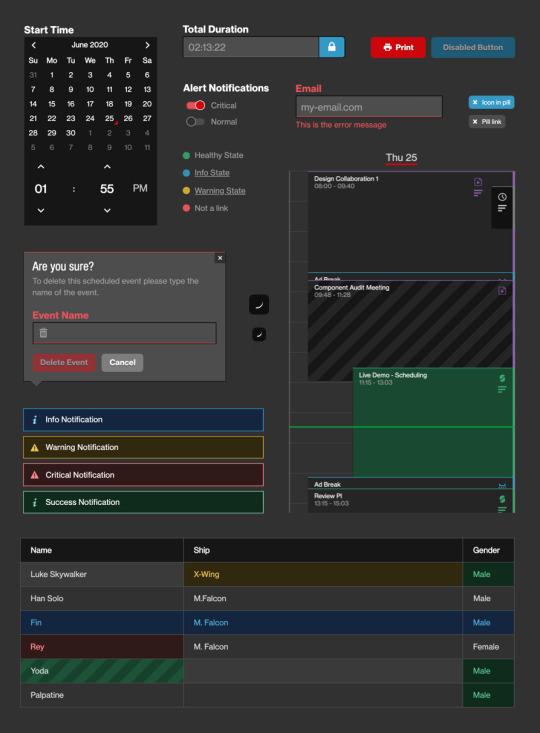
Theming
One problem with using a design system or library is that you are often forced to use the visual style that comes with it. With Bindable you can customize how it looks to fit your visual style. This is accomplished through CSS custom properties. You can create your own custom theme by setting these variables and you will end up with your own visual style.
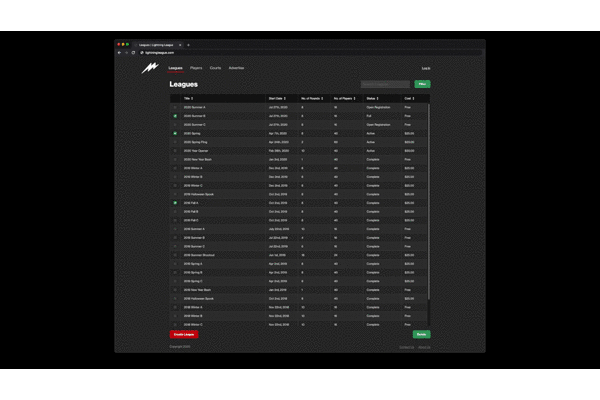
Modular Scale
Harmony in an application can be achieved by setting all the sizing and spacing to a value on a scale. Bindable has a modular scale built in. You can set the scale to whatever you wish and it will adjust. This means your application will have visual harmony. When you need, you can break out of the modular scale for custom sizing and spacing.

Aurelia
Aurelia is a simple, powerful, and unobtrusive javascript framework. Using Aurelia allows us to take advantage of its high performance and extensibility when creating components. Many parts of Bindable have added features thanks to Aurelia.
Tokens
Tokens are small building blocks that all other parts of Bindable use. They are CSS custom properties and set things like colors, fonts, and transitions.
Layouts
The issue of creating the same layout using multiple methods is solved by Layouts in Bindable. Some of the Layouts in Bindable make it easy to set a grid, sidebar, or cluster of items in a row. Layouts also handle all the spacing between components. This keeps all your spacing orderly and consistent.
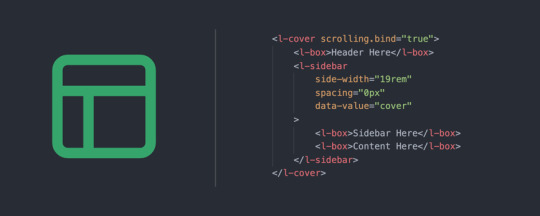
Components
Sharing these components was one of the principal reasons the library exists. There are over 40 components available, and they are highly customizable depending on your needs.

Access Modifiers
Bindable allows developers to easily change the state of a component on a variety of conditions. Components can be hidden or disabled if a user lacks permission for a particular section of a page. Or maybe you just need to add a loading indicator to a button. These attributes make it easy to do either (or both!).
Value Converters
We’ve included a set of value converters that will take care of some of the most basic conversions for you. Things like sanitizing HTML, converting CSV data into an array, escaping a regex string, and even more simple things like capitalizing a string or formatting an ISO Date string.
Use, Contribute, & Reach Out
Explore the Bindable website for helpful details about getting started and to see detailed info about a given component. We are excited to share Bindable with the open source community. We look forward to seeing what others build with Bindable, especially Aurelia developers. We welcome pull requests and feedback! Watch the project on GitHub for updates. Thanks!
Acknowledgements
Cam Debuck, Ajit Gauli, Harley Jessop, Richard Austin, Brandon Drake, Dustin Davis
0 notes
Text
Senior Full Stack Developer
New Post has been published on https://www.tuempleord.do/2021/01/08/senior-full-stack-developer/
Senior Full Stack Developer

You will be part of an amazing team helping with the design and development for one of the leading companies of fleet mobility solutions for dealerships, automotive manufacturers, automotive groups, and car rentals.
The project consists of web-based fleet management software solutions to manage business’ rental and loaner car fleets. It combines an innovative approach to software with extensive industry knowledge to bring rental car businesses high-performance software products that exceed their expectations.
Responsibilities: Work with Product Owners to drive product vision, manage scope, and client expectations. Learn, adhere to, and enforce clients’ standards and best practices. Deliver the highest quality designs and code for the project. Participate in SCRUM team ceremonies (daily stand-up, planning sessions, etc.). Provide estimates for tasks. Provide progress updates to the team while working on tasks. Research and troubleshooting issues in QA and production. Adhere to SOLID principles. Develop and maintain effective working relationships with team members.
Must-haves: 4+ years of experience with any modern JavaScript framework; Aurelia, Angular, React, Vue, etc. 4+ years of experience with .NET – C# Develop WebAPIs from the ground up. Familiarity with database technology such as SQL Server, MySQL, Oracle. Experience with git. Experience with Redis.
Nice to have: Experience leading/mentoring other developers. Good time-management skills. Outstanding multitasking skills. Solid communication and interpersonal skills. Being a quick learner.
Please send over your resume to [email protected]
0 notes
Photo

Fun and games with JavaScript
#484 — April 17, 2020
Unsubscribe : Read on the Web
🕹 If you're bored this weekend at all, consider joining the latest Ludum Dare — it's an online game jam that's been taking place for 18 years and more JavaScript entries are appreciated against all the Unity crowd 😂
JavaScript Weekly

Writing an 'Emulator' in JavaScript (and Interfacing with Multiple UIs) — This is really neat. Tania built a Chip-8 interpreter in JavaScript and has gone into quite a bit of detail about what was involved here. Lots of neat bits and pieces to pick up from this.
Tania Rascia
jQuery 3.5.0 Released — I know many of you will groan, but I’m delighted when I see a new jQuery release. It’s still so heavily used. No headline features though, this is a security fix for a cross-site scripting vulnerability, plus some tweaks and fixes in preparation for jQuery 4.0 (yes!)
Timmy Willison (jQuery Foundation)
Build a Game of Battleship with TypeScript & Java. Free Course — Join over 2000 developers creating a game of Battleship with TypeScript, Spring Cloud Stream (Java), and PubSub+. This free 30-minute course is a great way to learn the basics of messaging and event-driven architecture with the Aurelia framework.
Solace sponsor
Profiling React.js Performance — Goes into detail on aspects of the React Profiler API, React’s new experimental Interaction Tracing API, and measuring custom metrics using the User Timing API.
Addy Osmani
Userscripts are Fun and Still Very Much Relevant — ‘Userscripts’ are basically JavaScript programs that run in the context of other Web pages so you can add your own features. They were really popular for a while but still exist and are still a neat use case for using JavaScript to improve your Web experience.
Eldad Bercovici
Another Look at What's New in ECMAScript 2020 — We linked to Dr Axel’s roundup recently, but here’s another take, looking at dynamic imports, nullish coalescing, optional chaining, BigInt, and more.
Ianis T.
⚡️ Quick Releases
Node 13.13.0 — File system API tweaks, and more.
jQuery 3.5 — So classic we had to link it twice.
Cypress 4.4.0 — Testing framework. Now supports TypeScript without plugins.
Discord.js 12.2 — Interact with Discord from Node.
💻 Jobs
JavaScript Developer at X-Team (Remote) — Join the most energizing community for developers. Work from anywhere with the world's leading brands.
X-Team
Senior JavaScript Developer (Warsaw, Relocation Package) — Open source rich text editor used by millions of users around the world. Strong focus on code quality. Join us.
CKEditor
Find a Job Through Vettery — Vettery specializes in tech roles and is completely free for job seekers. Create a profile to get started.
Vettery
📚 Tutorials
How To Create a Particle Trail Animation in JavaScript — Particle animations are particularly (sorry) striking.. and in this article, Anna Prenzel shows how to easily create your own such effects with Anime.js.
Smashing Magazine
Strategies for Migrating to TypeScript — A quick overview of some strategies for migrating code bases from JavaScript over to TypeScript.
Dr. Axel Rauschmayer
Developing in a Monorepo While Still Using Webpack — Second part in a series discussing things the team at Etsy learned during the migration of a home-grown, Require.js-based build system to webpack, which took over a year.
Salem Hilal
A More Productive Way to Build Your JavaScript Apps — Write better code, debug it, and test it – all in one place. Try WebStorm. No configuration required.
WebStorm sponsor
▶ Let's Build a Digital Circuit Simulator in JavaScript — A special episode of the Low Level JavaScript series takes us on a brief journey into the world of digital logic.
Low Level JavaScript
How To Set Up an Express API Backend Project with PostgreSQL — A pretty extensive walkthrough of creating an HTTP API using Express with Node.js and Postgres on the backend, then deploying it all on Heroku.
Chidi Orji
Speed Up Your Angular App: 14 Optimization Tips — Tips on how to make your Angular app smaller, faster, and more responsive.
Marcelo Ricardo de Oliveira
Class-Related Types in TypeScript
Dr. Axel Rauschmayer
📅▶ A Fireside Chat on the State of Microservices on April 21 — We recently helped The Software House with a developer survey (thanks to those who took it!) and now they’re doing a live chat on the state of microservices next Tuesday featuring Yan Cui, Alessando Vozza, and others.
The Software House
🔧 Code & Tools

Puppeteer 3.0: It Now Supports Firefox — Best known for as a way to headlessly control Chrome from Node, Puppeteer has recently seen some competition in the form of the cross-browser Playwright recently. But, no fear, Puppeteer is stepping up and can now work cross-browser too. We also learn Puppeteer is migrating to TypeScript.
Mathias Bynens
Open-Source Serverless CMS Powered by React, Node.js and GraphQL API — Build dynamic websites and apps with Webiny. 100% powered by JavaScript. Deploy your sites to AWS Lambda.
Webiny Serverless CMS sponsor
Rome: An Experimental JavaScript Toolchain — A compiler, linter, formatter, bundler, testing framework and more. Started by Sebastian McKenzie (of Babel and Yarn fame), Rome is now a project from the React Native team at Facebook. Related repo.
Facebook
Vime: A New, Modern Media / Video Player for the Web — Aims to be a ‘modern alternative to Video.js and Plyr’: “The idea behind Vime is we want you to control the player, not the other way around.” Modular, tree-shakable, and with potential for a plugin ecosystem. GitHub repo.
Rahim Alwer
Vuln Cost: An Open Source Security Scanner for VS Code — Free Snyk-powered VS Code extension that finds security vulnerabilities in npm packages, providing feedback in-line with your code, such as how many vulnerabilities a package has.
snyk
ip-num: A Library to Work with ASN, IPv4, and IPv6 Numbers — Happy in both Node and the browser.
dadepo

Flip: Animated Flip Counter Plugin to Add a Countdown to a Website — Adds an animated dynamic countdown timer to a page. No dependencies, responsive and mobile friendly, and fits any language, locale, or time zone.
Rik Schennink
The Perfect Partner to MongoDB Atlas. Try It for Free
Studio 3T sponsor
A JavaScript API for Controlling 'Simpsons: Hit & Run' — Including this as a bit of fun if you fancy noodling on something odd. Remote controlling games from JS seems neat, although I suspect just getting this running would take a while..
Tavis Ormandy
by via JavaScript Weekly https://ift.tt/3aeahRr
0 notes